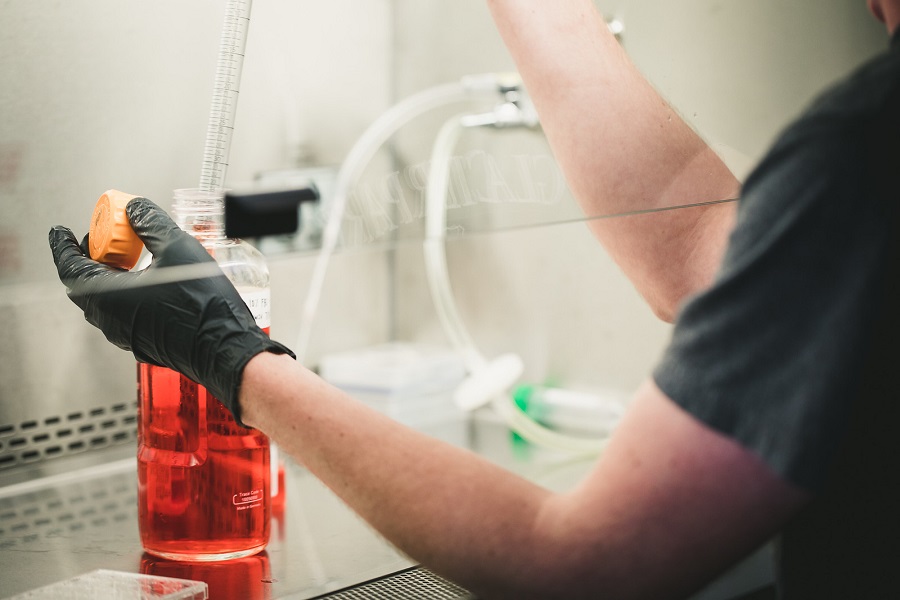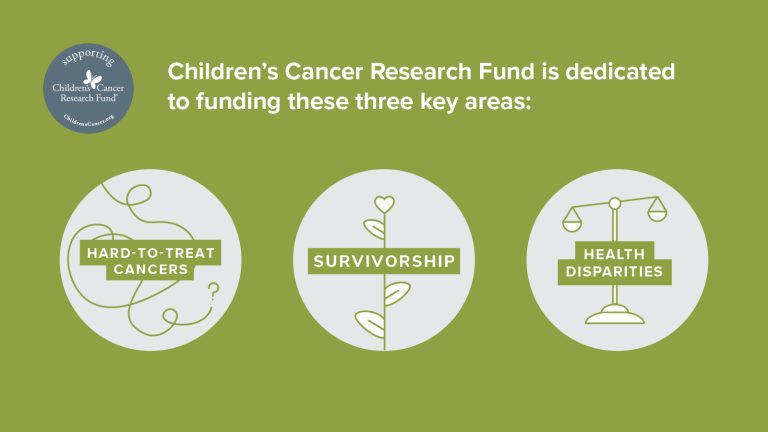Young scientists who want to dedicate their careers to finding better treatments for children with cancer face a tough road. Young researchers, who may not have as much of their own published research to make them stand out, rarely receive funding early in their careers. This means great ideas can go unexplored for years until the researcher has published enough of their own work to receive government grants. By supporting Children’s Cancer Research Fund, you are helping remove this roadblock for young researchers. The Emerging Scientist Award is a $100,000 grant designed to develop the independent research of highly qualified individuals still early in their careers. Here’s a glimpse into what our 2018 Emerging Scientists are working toward.
Less Toxic Treatments for AML
Every so often, as Dr. Cara Rabik is in her lab studying better treatments for acute myeloid leukemia (AML), she thinks of a patient she had when she was a resident years ago – the person who is the reason she’s studying this disease today.
“He’s the reason I became interested in AML,” Rabik said. “Watching his struggle really made a lasting impact on me. I’m still in touch with his family. It’s really because of him that I’m so driven to find better treatments for this disease.”
In about 10 percent of AML patients, researchers have found a genetic mutation called Wilms Tumor 1 (WT1). When WT1 is mutated, it can’t do its job correctly and certain necessary genes go unexpressed. Rabik’s goal is to learn more about this gene and what problems its mutations cause, then identify current drugs that can specifically target the cancer.
Currently, the only way to treat AML is with high-intensity chemotherapy, which deteriorates a child’s immune system to the point where it can be unsafe for them to leave the hospital. Rabik hopes her research will eventually yield a treatment that is less toxic, doesn’t put patients at high risk of infection and allows them to receive therapy on an outpatient basis.
Learn more about Dr. Rabik's research.
A Better Target – Making Ewing Sarcoma Cells Sensitive to Chemotherapy
“Relapse.” Metastatic.” These are the dreaded words too many Ewing sarcoma patients hear after weeks, even months, of cancer treatment. Patients with metastatic or relapsed Ewing sarcoma have a very poor prognosis, and Kelly Bailey, MD, PhD, dreads telling her patients. She says it places even more doubt and worry in their minds than before – it’s a conversation she wishes she never had to have.
In addition to practicing as a pediatric oncologist, Bailey is also researching why some cells in Ewing sarcoma tumors are more aggressive and less sensitive to chemotherapy. She is looking at a specific pathway that causes these cells to grow fast, and our goal is to find a drug we can use to target that pathway and kill the cells.
“We’re seeing that some of these cells have built up a resistance to current drugs, or have acquired new mutations that make them more aggressive,” Bailey said. “Ultimately, we’re looking for a better target.”
Learn more about Dr. Bailey's research.
Starving Cancer Cells – Blocking Glutamine in Aggressive B Cell Lymphoma
Glutamine, an amino acid, is in many of the foods we eat, like eggs, beef and milk. We need it to build proteins that make up our organs, it helps us heal from certain kinds of injuries and it supports immune system functions. However, for patients fighting aggressive B cell lymphoma, it may also feed the fast-growing cancer cells in their bodies.
Ji Zhang, PhD, a researcher at Indiana University, says his research so far indicates that these cancer cells need glutamine: they need to uptake it to support cell growth, and they need to utilize that glutamine to maintain key oncogenic signaling. Zhang thinks if he can find a way to block either of those processes from happening, he can starve the cancer cells of the fuel they need, making them more vulnerable to therapies that can kill them off.
“There are drugs out there right now that are used in lots of different types of cancer, but they’re less effective in B cell lymphoma, because the cells can evolve to bypass these initial therapies,” Zhang said. “I hope my research can increase the understanding of how these cells use glutamine so we can manipulate the cells and make them more sensitive to the drugs we use to treat other cancers effectively.”
Learn more about Dr. Zhang's research.
Making the Most Impact – Treating Childhood Brain Tumors
Pediatric brain tumors are the deadliest of all childhood cancers. They cause the most cancer-related deaths in children, and for patients with the most aggressive forms of this disease, there is currently no lifesaving therapy available.
Some may see this as one of the less hopeful areas of cancer research, but Stephen C Mack, PhD, from Baylor College of Medicine and Texas Children’s Hospital doesn’t see it that way.
Mack’s research looks at the epigenetic basis of pediatric brain tumors, meaning that rather than looking for mutations in genes that cause tumors, his team is looking at how the DNA is regulated by proteins. He believes that with a better understanding of these tumors, researchers may be able to create a drug or an immunotherapy treatment that can target tumor cells and kill them.
“If you think about studying cancer like reading a book, what some researchers do is search for errors in the text, like typos,” Mack said. “These kinds of tumors are different, so our approach has to be different, too. What my team is trying to do is more like changing the ‘font’. We need to learn more about what regulates this ‘font’ to devise new therapies.”
Support Emerging Scientists
By donating to Children’s Cancer Research Fund, you’re giving emerging scientists the support they need to put their great ideas into practice. Learn more about CCRF's commitment to funding researchers early in their careers.




